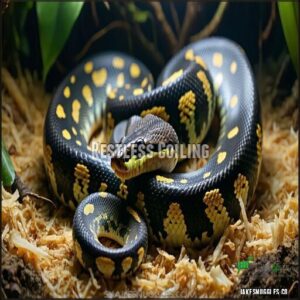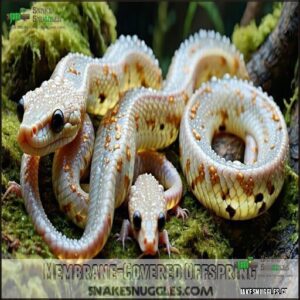This site is supported by our readers. We may earn a commission, at no cost to you, if you purchase through links.
 You’ll recognize signs of successful snake breeding when your female develops a visible mid-body swelling 2-4 weeks after mating.
You’ll recognize signs of successful snake breeding when your female develops a visible mid-body swelling 2-4 weeks after mating.
She’ll likely refuse food, seek warm spots, and become less active. For egg-laying species, you’ll observe nesting behavior as she searches for secure laying sites.
Live-bearing species show progressive abdominal enlargement. The ultimate success comes with healthy eggs (opaque, firm, and clinging together) or active, alert offspring.
Monitor for proper shedding and feeding in newborns. Like snake charming, breeding requires patience and attention to detail.
The specific timeline varies dramatically between species, with some fascinating adaptations we’ll explore next.
Table Of Contents
- Key Takeaways
- Snake Breeding Readiness
- Environmental Factors
- Mating Process
- Pregnancy Signs
- Breeding Success Indicators
- Frequently Asked Questions (FAQs)
- How Long Does It Take for Snake Eggs to Hatch?
- What is the Best Way to Handle Snakes During the Breeding Process?
- What Type of Environment Should I Provide for the Snake Babies?
- Are There Any Special Dietary Needs for Snakes During Breeding Season?
- How Often Should I Check on the Eggs or Snake Babies?
- How to tell when snakes are ready to breed?
- What does a female snake do after mating?
- How much money do snake breeders make?
- What are the behaviors of snakes mating?
- What about snake combat prior to mating?
- Conclusion
Key Takeaways
- You’ll recognize successful breeding when your female snake develops visible mid-body swelling 2-4 weeks after mating, refuses food, seeks warm spots, and becomes less active.
- You’ll need to create the right environment with proper temperature gradients (90-92°F basking zone, 75-78°F cool side), humidity levels (50-70%), appropriate photoperiod cycles, and suitable substrate for nesting.
- You’ll observe distinct courtship behaviors like tongue flicking, head bobbing, and tail coiling before successful mating, followed by pregnancy signs including swollen abdomen, nesting behavior, and restless coiling.
- You’ll confirm breeding success through either healthy egg-laying (with eggs that are opaque, firm and clinging together) or live birth, followed by active, alert offspring with proper feeding responses and steady growth rates.
Snake Breeding Readiness
You’ll know your snake is breeding-ready when its health, genetics, and behavior all check out.
Start with a veterinary exam, confirm the right weight, and make sure both snakes are in top condition for successful mating.
Genetic Screening
Genetic screening is your first step to ensuring strong bloodlines and avoiding inbreeding risks.
It confirms snake genetics, identifies temperament genes, and excludes health issues.
By spotting potential problems early, you’ll protect your snakes’ genetic diversity.
Plus, testing helps you predict snake morphs, making breeding projects exciting and precise, like choosing the perfect pieces for your genetic puzzle!
Temperament Assessment
Temperament assessment can’t be skipped when evaluating snake breeding signs.
Observe stress responses, handling ease, and docility scoring to guarantee compatibility.
Watch for individual variation in aggression triggers during introductions.
Snakes displaying stable behavioral changes during courtship behaviors and mating behaviors are often ideal candidates.
Knowing your snake’s mood swings might save you from an unexpected hiss—or worse!
Ideal Weight and Physical Condition
Once you’ve assessed temperament, focus on breeding weight and muscle mass.
Healthy snakes need consistent growth, not rapid bulking.
A male’s ideal breeding weight starts at 800 grams, while females should exceed 1500 grams.
Feeding management matters—ensure steady weight gain without overfeeding.
Regular health assessments keep snake health in check, laying the groundwork for successful snake breeding preparation and healthy snakes, which is crucial for healthy snakes.
Veterinary Checkup
A quick vet visit can save loads of trouble during snake breeding. A veterinarian consultation confirms parasite screening, reproductive health checks, and health certifications are up to date. They’ll also flag any genetic anomalies or health risks.
Maintaining proper snake enclosure hygiene is also vital for preventing common health issues.
- Preventative care reduces breeding issues.
- Check for parasites to guarantee healthy snakes.
- Review reproduction health for readiness.
- Ensure hydration and weight are ideal.
- Plan follow-ups for ongoing health assessments.
Environmental Factors
When breeding snakes, getting the environment just right isn’t optional—it’s essential.
You’ll need to focus on temperature, humidity, lighting cycles, and substrate to mimic their natural habitat and support healthy reproduction.
Temperature Gradients
Temperature gradients are essential for snake breeding and egg incubation.
Create a basking zone at 90-92°F, with the cool side around 75-78°F, ensuring proper thermal regulation.
This gradient keeps snakes comfortable and mimics nature.
Adjust based on species needs for breeding success.
| Zone | Temperature Range | Purpose |
|---|---|---|
| Basking Zone | 90-92°F | Digestive activity boost |
| Warm Side | 85-88°F | Active comfort zone |
| Cool Side | 75-78°F | Resting zone, stress relief |
| Middle Gradient | 80-85°F | Passage and roaming space |
| Incubation Zone | 78-88°F | Egg viability and development |
The temperature gradient is crucial for the well-being of the snakes, and the provided table outlines the different zones and their purposes, including the incubation zone for egg development.
Humidity Management
Humidity plays a huge role in a snake breeding environment. You’ll need high humidity to support shedding success, respiratory health, and egg incubation.
Keep levels between 50-70%—too high invites mold, too low dries out eggs or skin. Many keepers purchase snake humidity products to help maintain proper levels.
- Use hygrometers for precise humidity monitoring.
- Mist the enclosure lightly if it’s dry.
- Pick moisture-retaining substrates.
- Check humidity affects shedding regularly.
Photoperiod Control
Matching your snake’s photoperiod to natural cycles can enhance breeding success.
A gradual light cycle shift mimics seasonal simulation, triggering melatonin production and breeding responses.
Photoperiod duration is vital—maintain consistent lighting patterns.
Effective breeding also requires a consistent heat source.
| Light Cycle | Duration (hours) | Purpose |
|---|---|---|
| Daylight | 12-14 | Stimulate breeding trigger |
| Dimming | 10-12 | Seasonal alignment |
| Darkness | 8-10 | Support melatonin production |
These adjustments optimize snake breeding conditions effectively.
The use of a consistent heat source and proper light cycles can significantly improve breeding outcomes.
Substrate Selection
Choosing the right substrate for a snake breeding environment is essential for success.
It supports moisture retention, egg incubation, and snake comfort.
Substrate also prevents mold, meeting burrowing needs.
Always pick substrates like coconut fiber or aspen shavings, considering cleanliness and hatchling safety.
Avoid sand to prevent ingestion risks.
Many breeders find coir is beneficial for humidity.
- **Opt for moisture-retentive materials.
- **Ensure easy cleaning.
- **Provide burrowing opportunities.
- **Use mold-resistant options.
Mating Process
When snakes are ready to mate, you’ll see fascinating behaviors like tail curling, gentle nudging, and tongue flicking as part of their courtship.
Timing, pheromones, and proper environmental conditions play a huge role in ensuring the process goes smoothly.
Courtship Behaviors
During courtship, you’ll notice fascinating snake mating behaviors like tongue flicking, head bobbing, or tail coiling.
Males use their spurs to tickle females, hoping to spark interest. Female choice dictates success, so patience is key.
Snake courtship rituals can resemble a slow dance—graceful yet deliberate, with behaviors like head bobbing and tail coiling. Keep watch for these courtship displays, as they’re vital signs of readiness and compatibility.
Snake courtship is nature’s elegant ballet—graceful tail coils and rhythmic head bobs signaling passion and readiness beneath the scales.
Pheromone Trails
As courtship behaviors intensify, pheromone trails take center stage in snake breeding.
Female snakes use scent communication, leaving subtle pheromone trails that guide males.
This trail-following simplifies mate searches.
Here’s how it works:
- Females signal reproductive readiness through pheromones.
- Males detect pheromones using their tongue and Jacobson’s organ.
- Larger females attract more mates.
- Post-mating signals prevent further advances.
- Species variation affects trail-following behavior.
The process of trail-following is crucial for successful mating, as it allows males to locate females efficiently, highlighting the importance of scent communication and reproductive readiness.
Male and Female Interactions
Understanding snake courtship rituals can be fascinating.
Watch for courtship behaviors like tongue flicking and gentle spur tickling.
Mating balls often form, especially in competitive species.
Be alert for aggression signs—separate involved snakes if things escalate.
Females hold the cards in sperm storage and mate selection.
These behaviors are often guided by female pheromone production.
Here’s a quick table to simplify male-female interactions:
| Aspect | Behavior |
|---|---|
| Initiation | Spur tickling, nudging |
| Female Choice | Reject or accept male |
| Aggression Signs | Biting, striking |
| Mating Ball | Multiple males |
| Mating Duration | 1-24 hours |
Successful Mating Indicators
In successful snake breeding, watch for locking behavior, where snakes remain connected for hours during copulation.
Female choice plays a key role, as receptive females encourage mating behaviors like coiling or forming a mating ball.
Sperm storage allows females to fertilize eggs later, and aggression absence is vital—separate snakes if needed to guarantee a stress-free environment for successful snake mating behavior.
Pregnancy Signs
You’ll notice key pregnancy signs like a swollen abdomen and changes in behavior as your snake progresses toward egg development.
Keep an eye out for nesting activity and restless coiling, which often signal that things are moving along smoothly, showing complete concepts of the snake’s development.
Swollen Abdomen
When observing snake breeding, a swollen abdomen is one of the first gravidity signs you’ll notice.
Gravid females often show visible weight gain as follicles develop. Palpation findings by experienced breeders can confirm this, though it’s not for the faint-hearted.
Feeding changes, like reduced appetite, also signal snake pregnancy. These observations guarantee your breeding efforts stay on track, ensuring a successful outcome with proper breeding efforts.
Nesting Behavior
A female snake’s nesting behavior signals she’s preparing for egg-laying. Watch for her exploring the nesting box or arranging materials.
Here’s what to note:
- Substrate preference—soft, moist bedding works best.
- Nesting frequency—daily visits increase.
- Clutch placement—eggs are carefully positioned.
- Nest construction—she shapes her surroundings.
- Abandonment causes—stress or unsuitable conditions disrupt nesting.
Keep her calm and comfortable.
Restless Coiling
As pre-laying behavior kicks in, you’ll notice restless coiling—a clear sign of snake breeding readiness.
Stress-induced coiling often stems from enclosure size impact or unsuitable conditions. Adjust the substrate preference to match their needs, as coiling frequency changes signal discomfort or nesting instincts.
Keep an eye on these behavioral changes to guarantee your snake’s breeding journey stays on track. Gravid snakes may also display increased aggression and restlessness due to hormonal shifts.
Membrane-Covered Offspring
Restless coiling signals labor, but membrane-covered offspring add another layer of wonder.
Boa constrictors birth live young wrapped in a clear membrane, aiding hydration importance.
Healthy hatchling snakes break free themselves, but weaker ones may struggle.
Mothers sometimes assist, ensuring snake offspring survival.
Post-hatch care begins as baby snakes shed and feed, confirming successful hatching and healthy snake eggs.
Breeding Success Indicators
You’ll know your breeding efforts paid off when you see clear signs like egg-laying or live birth, depending on the species.
Healthy offspring, free of deformities, and steady survival rates are key indicators of success.
Egg-Laying
When it’s time for egg-laying, you’ll notice the female seeking a quiet, secure spot.
Snake clutch size varies by species, often ranging from 2-30 eggs.
To promote healthy snake eggs, provide soft, moist substrate and monitor humidity.
Incubation methods depend on maintaining steady temperatures.
Proper care during this phase guarantees egg fertility and boosts your snake breeding success.
A proper nesting environment is vital for successful breeding.
- Watch for nesting behavior.
- Provide a nesting box.
- Maintain 78-88°F incubation temperature.
- Keep humidity at 50-70%.
- Check eggs for mold or damage.
Live Birth
Live-bearing snakes, like boas, skip egg-laying and give birth to fully formed young—a process called viviparity.
Gestation length varies by species, often lasting months. Placental development supports embryos, showing remarkable maternal investment.
For successful snake breeding, monitor neonate survival closely. Think of the mother as a reptilian superhero, carrying her offspring until they’re ready for the world.
| Aspect | Description | Importance | Example |
|---|---|---|---|
| Viviparity Explained | Birth without eggs | Unique to some species | Boa constrictors |
| Gestation Length | Months-long pregnancy | Prepares neonates for birth | 4-6 months in boas |
| Placental Development | Embryo nourishment | Supports healthy offspring | Nutrient-rich placenta |
| Maternal Investment | Extended care during gestation | Boosts neonate survival | Protective mothers |
Healthy Offspring
Healthy offspring start with proper incubation, ensuring baby snake hatching goes smoothly.
Watch for hatchling vigor—active, alert babies signal strong genetic health. A good feeding response and steady growth rate confirm snake development is on track.
Baby snake care includes offering appropriately sized prey and maintaining consistent conditions. Healthy snakes thrive with attention to their environment and nutrition, ensuring robust snake health with a focus on genetic health.
Parental Care and Offspring Survival
Unlike many reptiles, most snake species show minimal parental care after birth.
Most snakes leave their young to thrive independently, relying on instinct and strong genetics for survival.
You’ll want to monitor hatchling feeding closely, as baby snake care begins immediately post-hatching.
Environmental enrichment substantially impacts postnatal survival rates.
Snake development progresses independently, with genetic health determining long-term viability.
Incubation success directly influences offspring quality—proper snake egg incubation temperatures (78-88°F) maximize hatchling health and reduce mortality in those vital first weeks, which is crucial for long-term viability.
Frequently Asked Questions (FAQs)
How Long Does It Take for Snake Eggs to Hatch?
Imagine this: tiny eggs resting snugly in perfect conditions, waiting to reveal their secrets.
Snake eggs typically hatch in 50-90 days, depending on species, temperature, and humidity. Ball pythons, for instance, take 55-65 days.
Different species require specific conditions, so research reptile incubation guidelines is essential for success with reptile incubation.
What is the Best Way to Handle Snakes During the Breeding Process?
Minimize handling during breeding to reduce stress.
When necessary, use gentle hook-and-tail techniques, keeping interactions brief.
You’ll need to maintain proper temperatures and provide privacy for the snakes throughout the breeding process.
What Type of Environment Should I Provide for the Snake Babies?
Just as you’d want a cozy nursery, provide baby snakes with small enclosures that maintain 78-88°F temperatures.
You’ll need proper humidity (50-70%), secure lids, hiding spots, shallow water dishes, and appropriate substrate to ensure their well-being.
Are There Any Special Dietary Needs for Snakes During Breeding Season?
You’ll need to feed female snakes more frequently as they develop eggs, while males may fast during breeding.
Provide appropriately sized prey and consider calcium supplements to support the female’s reproductive health.
How Often Should I Check on the Eggs or Snake Babies?
For eggs, check once daily without handling them.
For babies, observe twice daily during their first week, then reduce to daily checks.
Don’t disturb them excessively—they’re fragile and stress easily.
How to tell when snakes are ready to breed?
You’ll see unmistakable signals when your snakes are breeding-ready.
Look for recent shedding, healthy weight (800+ grams for males, 1500+ grams for females), increased activity, and courtship behaviors like tongue flicking and tail coiling.
These signals, including healthy weight, indicate that your snakes are ready to breed.
What does a female snake do after mating?
After mating, your female snake will stop feeding, develop follicles, and gain weight rapidly.
She’ll become more reclusive, seeking nesting spots while her body prepares for either egg-laying or live birth, depending on species.
How much money do snake breeders make?
Contrary to popular belief, you’ll likely lose money breeding snakes unless you’re working at scale.
Your earnings vary dramatically – from a few thousand dollars to potentially millions annually, depending on rare morphs and business scale.
What are the behaviors of snakes mating?
During mating, you’ll notice male snakes tickling females with spurs, increased activity, tongue flicking, and head bobbing. They’ll coil tails and lock together for 4-24 hours during successful copulation.
What about snake combat prior to mating?
Like gladiators in ancient Rome, male snakes will wrestle and entwine with rivals before mating.
You’ll notice them rising up, pushing against each other, and attempting to pin competitors down to establish dominance.
Conclusion
Like delicate puzzle pieces falling into place, the signs of successful snake breeding reward your dedicated care and attention.
You’ll know you’ve succeeded when healthy offspring emerge, whether from carefully incubated eggs or live birth.
Remember that each species has unique requirements, but the fundamentals remain consistent: proper preparation, environmental control, and careful monitoring.
With patience and these expert guidelines, you’ll soon be welcoming the next generation of slithering companions to your collection, following the path of dedicated care.
- https://www.reptiles.swelluk.com/help-guides/snake-breeding-guide/
- https://ballpython.ca/breeding/
- https://familysnake.com/guides/love-in-the-air-managing-your-pet-snakes-mating-season/
- https://reptilesupershow.com/mastering-snake-breeding-tips-for-healthy-serpents/
- https://www.ozzyboids.com/post/the-millionaire-snake-breeder-blog-breeding-temps

















